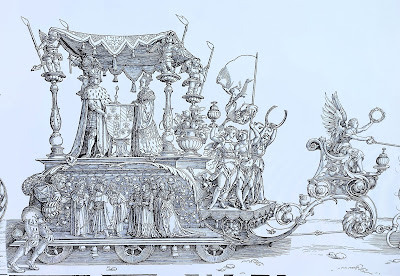On Maximilian's 500th death anniversary in 2019, Freiburg's Alemannisches Institute organized a three-day excursion to the exhibition with the above title at Tirol Castle in South Tyrol, followed by a visit to Innsbruck, where the emperor's (empty) tomb is located.

|
| A tournament with Maximilian winning. |

|
| Maximilian on horseback |

|
|
The White King dictates to four scribes from his life and has a war campaign painted. |
Maximilian's triumphal procession

|
| Maximilian's great triumph cart |
Maximilian's triumphal arch
Innsbruck

|
|
The most famous Golden Dachl, the initial residence of the Habsburgs in Innsbruck |

|
| Visiting the Hofburg with the dome of Innsbruck's cathedral in the background |

|
| A cross above Innsbruck's cathedral |

|
| To the left: Cafe Sacher. In the background is the cupola of the Hofkirche. |

|
| At Sacher, being observed ©PBöhm. |
The Hofkirche
Maximilian had planned to decorate his tomb with 40 bronze statues, but only 28 were completed. The figure captions below are copies of the inscriptions at the bases of those statues.
Maximilian's ancestors
The Habsburgs started off when Rudolf I was elected German king in 1273. In 1291, his son Albrecht (Albert) followed. He was assassinated in 1298 when the House of Luxembourg took over, providing the German kings. But when Emperor Sigismund, the last male member of the House of Luxembourg, died, he left only one daughter. She was married to a Habsburg, Albert, who became King Albrecht II of Germany from 1438 to 1439. In 1440, the electors chose Albert's cousin, Frederick, and Maximilian's father, as successor, who ruled until 1493. Contrary to Maximilian, Frederick III was called the Reichserzschlafmütze (arch-sleepyhead of the empire)
|
|
Maximilian's wives
They write that Maximilian had truly loved his first wife, Maria of Burgundy, and that he married his second wife, Bianca Sforza, because of her dowry of 400,000 ducats.
Still, Maximilian kept incurring debts also during the imperial diet held in Freiburg in 1498. When Maximilian took leave from the city, he left Bianca behind as a pledge. She had to stay in Freiburg for some time until at least part of Maximilian's debts incurred during the Reichstag had been paid. Twenty years later, the financial claims of over 20,000 guilders were still outstanding. Read more about Maximilian and his love for Freiburg in German.
|
|
The Burgundy Heritage
Ruling Burgundy, acquired by marriage, was important to the Habsburgs, as it gave them claims on territories ruled by France.
Duke Philip the Good had led Burgundy to bloom, but his son Charles the Bold wanted even more. So he went to war against the rest of the world. On 2 March 1476, Charles lost his hat in the Battle of Grausen (Grandson) against the Swiss Confederates and lost his estate in the same year on 22 June at Murten (Morat) against an alliance of Swiss, Lorraine, and Austrian troops.
That's not all, because, in one last show of strength in the following year, when the Duke put all his eggs in one basket, he eventually lost his blood in the Battle of Nancy. Charles's fate rhymes in German: He successively lost his Hut, Gut, and Blut. He blew it all. Is this why his statue is a head smaller than the others? Read about the history of Burgundy in German.
There are two more historical spolia inside Innsbruck's Hofkirche.

|
|
Tomb of
Andreas Hofer, a Tyrolean freedom fighter against Napoleon and his allied Bavarians |

|
|
Commemorating the conversion of Queen
Christina of Sweden
to Catholicism. Although the Hofkirche is run by the Franciscans, this, indeed, must have been a Jesuit ploy or even plot. |

























No comments:
Post a Comment